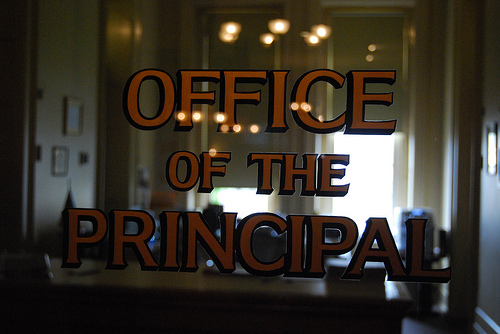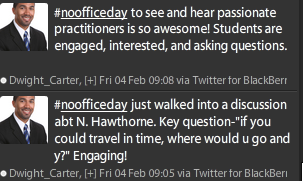 Sometime in December, 2010 I read a blog post by David Truss, principal of a school in Dalian, China titled, “No Office Day.” The title piqued my interest, but what really got my attention was something he wrote. “If a principal stays in the office all day, he/she might as well stay at home.” OUCH! Two things happened when I read this. First, I got excited about the possibilities and thoughts of what a “No Office Day” would like for me and secondly I felt conviction by my lack of presence, visibility, and connection with my staff and students.
Sometime in December, 2010 I read a blog post by David Truss, principal of a school in Dalian, China titled, “No Office Day.” The title piqued my interest, but what really got my attention was something he wrote. “If a principal stays in the office all day, he/she might as well stay at home.” OUCH! Two things happened when I read this. First, I got excited about the possibilities and thoughts of what a “No Office Day” would like for me and secondly I felt conviction by my lack of presence, visibility, and connection with my staff and students.
I immediately thought of my very first staff meeting as principal in August of 2008. I publicly vowed that I was going to be visible in the hallways and classrooms on a regular basis. I had great intentions, but intentions get you nowhere. The first couple of months were as I imagined them to be. I was out and about, popping into classrooms, and standing at the major intersections in the hallway. You know, being visible, “managing by walking around.” However, as time passed, I found myself chained to my chair taking care of the necessary minutiae of the day (or days, or weeks). As the days, weeks, and now years have passed, about the only time I have taken to get into classrooms is that which is needed to do formal evaluations. Yikes! That’s not good!
So, on Wednesday, February 2, I sent out an email to my staff that included the following message:
NO OFFICE DAY– In order to visit more classrooms, I am having a NO OFFICE DAY on Friday, February 4. I will not be in my office the entire day (unless there is an emergency). I’ll see you around!
As David encouraged, I planned to send updates on Twitter using #noofficeday. So, on Friday, I sent out the following tweet:

What I heard and saw was so inspiring! My day began in an Advanced Composition class where the teacher was journaling along with the students. The assignment was a free write followed by an in-depth discussion about narratives. What was most intriguing about the lesson were the types of questions the teacher asked the students. It was like watching a master craftsman using intricate tools to complete a difficult cut. Not only did this occur in the Advanced Composition class, but in several other classes I observed.
I walked into another classroom where the teacher and students were having an in-depth discussion about Nathaniel Hawthorne and Transcendentalism vs. Anti-transcendentalism. The essential question was, “If you were able to travel in time, where would you go and why?” As soon I walked into the room, the teacher asked me the same question inviting me to join in! It was awesome. Before I left, I shared with the class what I just sent out into the twittersphere, which was public praise of the teacher:

Later that morning I had a very meaningful, honest, and heartfelt discussion with a highly respected teacher in the building. We discussed everything from current grading practices and student responsibility to accountability, among other topics. We just sat and talked with no pressure to hurry and get things done. I not only appreciated the time, but I appreciated just being able to actively listen.
As I traveled throughout the building I experienced groups of students working on an upcoming mock interview in Global Studies and a couple of students assisting each other with their pantomime speeches. But one of the best conversations I had was with our Student Council members. We talked for nearly 50 minutes about an issue we have recently faced. They asked some great questions, attentively listened, and worked together to come up with solutions. Our Student Council Advisor is truly developing leaders through this group’s experiences and I am so grateful for her work and her dedication to students.
The highlight of the day was a brief conversation I had with a student who, as a principal, I have known since she was in the sixth grade. It was near the end of the school day and she had earlier presented with a group of students at our Annual Science Symposium. She shared with me that her group earned a medal and she gave me the elevator summary of their project. I asked, “So how do you feel?” She said, “I am so tired, but I feel good about the work we did. It was so challenging, but I learned so much! And, I’m glad it’s over!” With that, we high-fived each other and went our separate ways. I had encountered yet another student, proud of herself and praising her teacher who provided an opportunity for students to stretch their learning.
As we begin each day at school, I share the Words of Wisdom, by Project Wisdom, and sign off by saying, “Make it a great day or not… the choice is yours.” Well, my No Office Day was truly a GREAT DAY!
Like David, I encourage you to have a NO OFFICE DAY and share the events of your day using #noofficeday. Have fun!
Be Great,
Dwight
